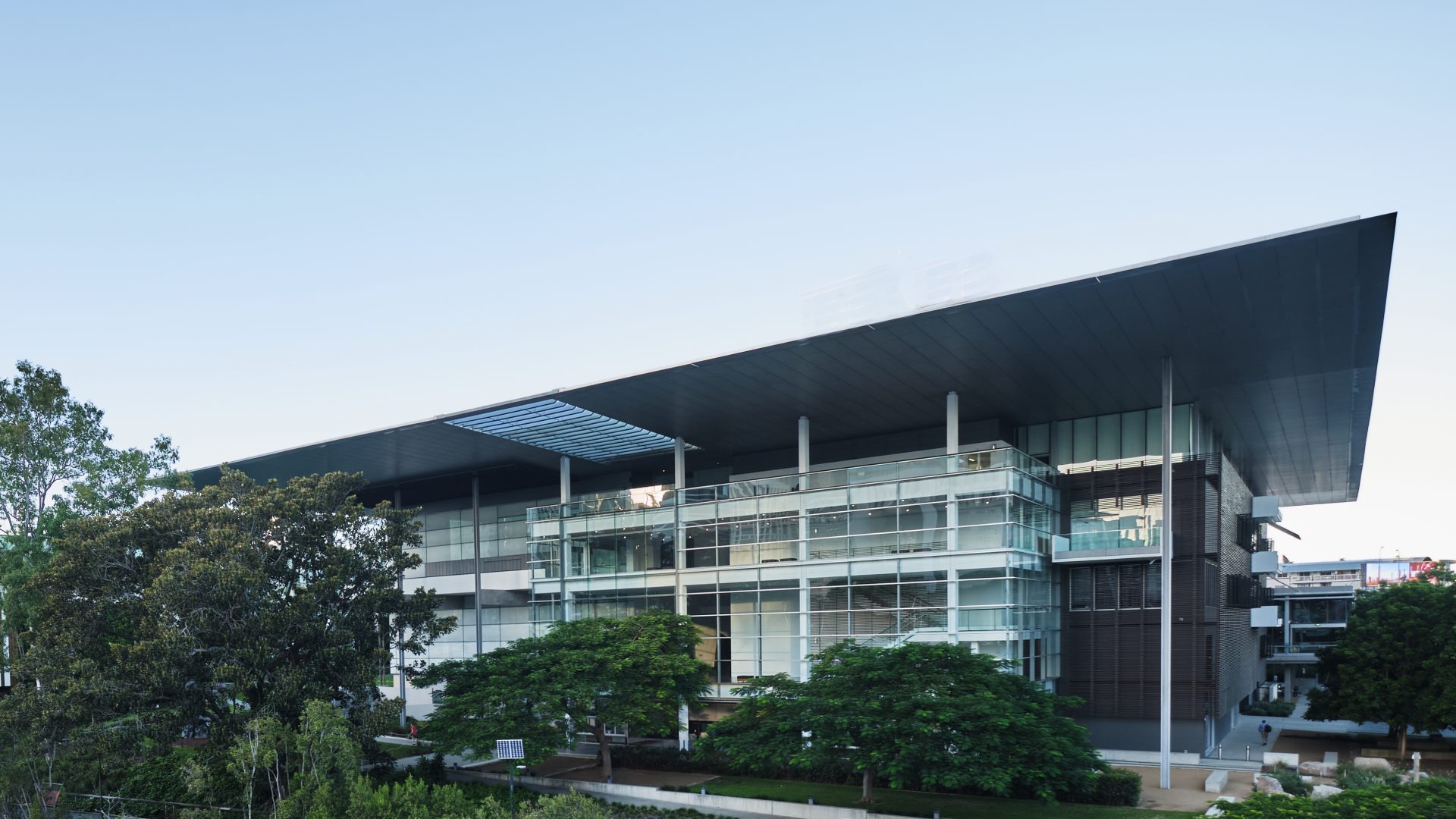The Queensland Art Gallery, designed by Robin Gibson and Partners, was completed in 1982 as part of the first stage of Brisbane’s South Bank Cultural Precinct.
Following an Architect Selection Competition, the Queensland Government commissioned Sydney-based firm Architectus to design a second building, the Gallery of Modern Art, known locally as GOMA.
The Gallery of Modern Art (GOMA) is yet another reason for sophisticated visitors to focus on the opposite side of the river from Brisbane’s CBD.
It dramatically counterpoints Robin Gibson’s early 1980s Queensland Art Gallery of spreading, part-sunken masonry with a wide-eaved and elegantly up-curved aerofoil blade roof topping a generously glazed, four-to-five-storey cubic form.
This approach contrasts the spaces and slices-versus-solids complexity of the adjacent State Library designed by by Donovan Hill with Peddle Thorp.
The GOMA building has an area of 25,635 m2, cost $290 million to build, and was completed in 2006.
The urban design concept for the Gallery acknowledges the city grid and axis of Tank Street, whilst maintaining the river connection for the West End district.
The design concept proposed a lightweight, open riverside pavilion containing two major levels of exhibition space, two cinemas, education facilities, a restaurant and boardwalk cafe.
The Gallery is organized into flexible, adaptive spaces which can house changing programs and exhibitions.
The new addition is an open, inviting, generous, and democratic ‘urban pavilion’ that enriches the cultural life of Brisbane.
Architects Kerry and Lindsay Clare saw the GOMA project has a unique opportunity to create a building that would be impressive and monumental but also direct, open, and fresh – international yet familiar, and responsive to the local conditions in South East Queensland.
Despite significant design involvement by Tasmanian architect James Jones when he worked at Architectus’s Sydney office in the early noughties, GOMA will be seen as a triumphant Queensland homecoming for Lindsay and Kerry Clare, the Buderim architects who led, with John Mainwaring and Gabriel Poole in the 1980s and 1990s, the Sunshine Coast style of light-edged residences and small pavilions.
Forced southwards because they could not then grow their small office into government work requiring quality assurance, the Clares became the founding directors of Architectus in Sydney, where they worked on large national and international projects.
They now practice at Clare Design, based in Sydney.
Now, whilst the rest of Brisbane’s cultural precinct is characterized by buildings arranged parallel to the Brisbane River, the Gallery of Modern Art is placed perpendicular to the river.
This strong gesture led to several urbanistic effects.
It created a public plaza fronting Stanley Street, allowed the new gallery to form a stronger relationship to the 1970s Queensland Art Gallery, created a sheltered outdoor public space near the river, and formed an enlarged public park at Kurilpa Point.
The gallery as a pavilion connects with the physical environment of the cultural precinct – with the public square, river, park, pedestrians, and street patterns.
This concept allowed the building to avoid the insularity that often characterizes art galleries.
The interior extends outwards, becoming a street that forms a clearly ordered, circulating pattern.
Visitors are encouraged to move to the centre of the building, where they can orient themselves and gain a sense of the overall floor plan before making a commitment to any direction.
There are 15 main gallery spaces and flexible areas that can housed additional exhibitions.
These spaces each have their own character and function and differ in scale, materiality, and use of light, becoming flexible frameworks for the respective artist and artworks.
Environmentally, the generous roof solves around 90% of the issues facing the Gallery by shading the walls at critical times of the day.
And the supporting technical systems ensure that the Art Gallery meets the necessary indoor climate requirements.
They control the temperature and humidity, provide artificial and natural light, control air-pollution, and optimise energy consumption.
The building’s design responds to the artists and curators need for flexibility and true to the Clares’ reputation for meticulous detail, all lighting tracks are recessed, the floor air grilles and ceiling mounted sound system components are precisely flush, and the gallery doors incorporate extremely deep, zinc-lined reveals that allow art to be stored in the cavities of adjacent double walls.
Externally, the building incorporates two major external walls of Starphire translucent glass, which allow dynamic light and video shows to transform the prime north-east and south-east corner of the building (as seen from the city and adjacent library).
Get New Architecture Guides
Sign up below to be notified when new Architecture Guides are published so you don’t miss any.

